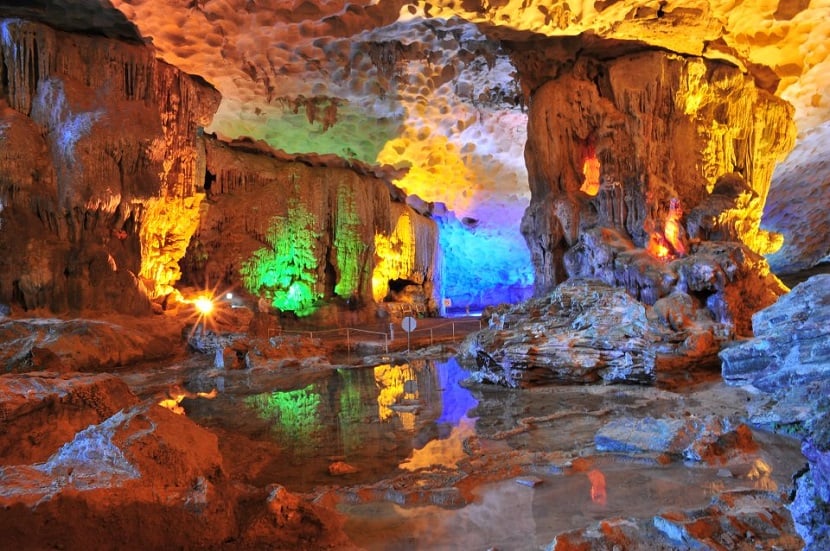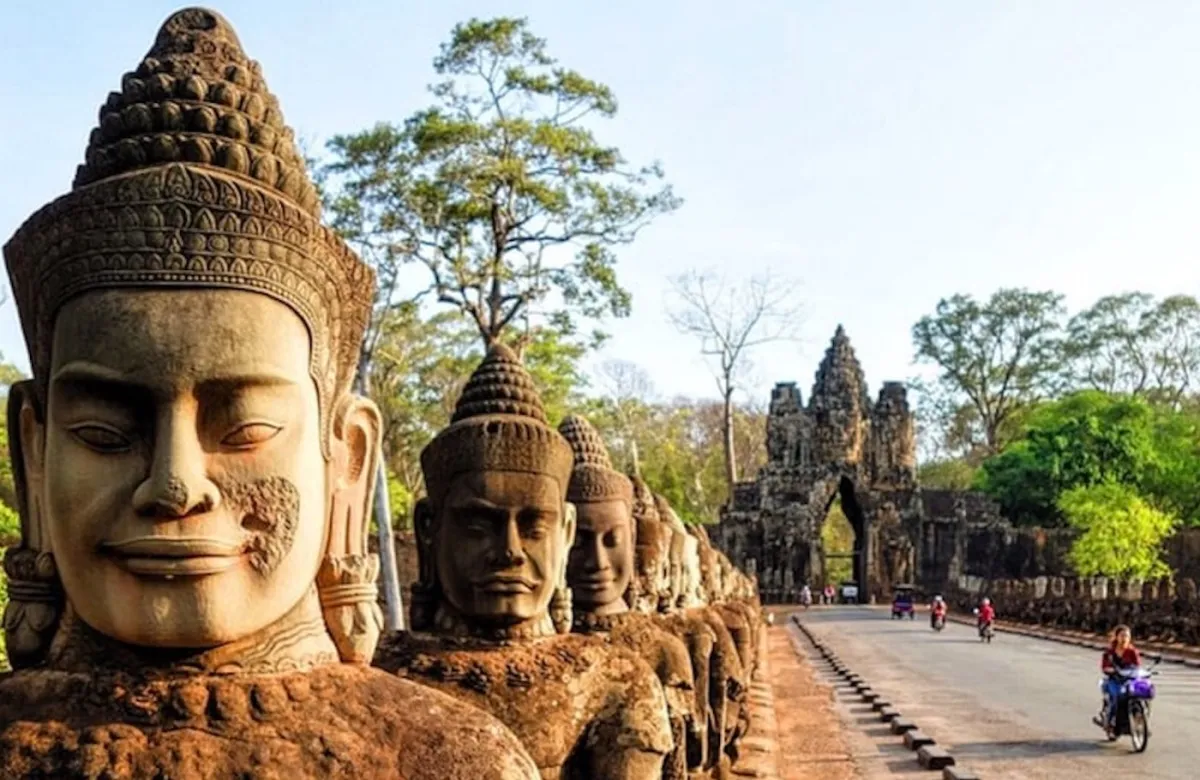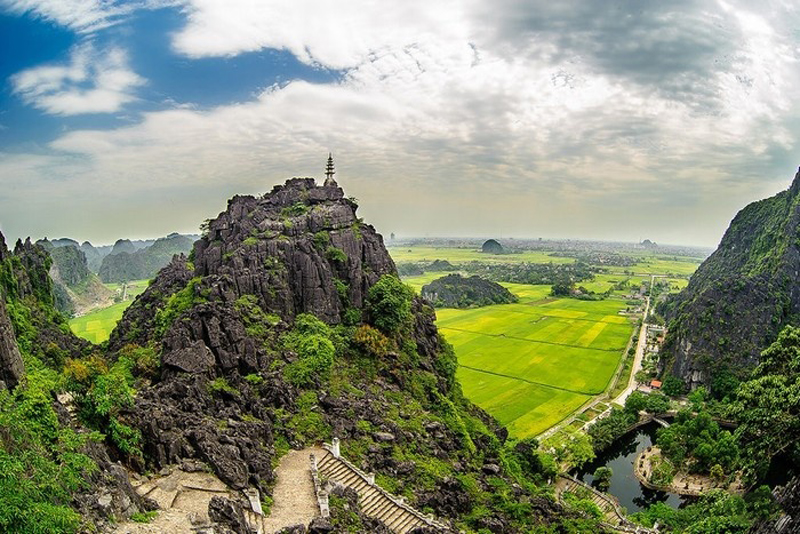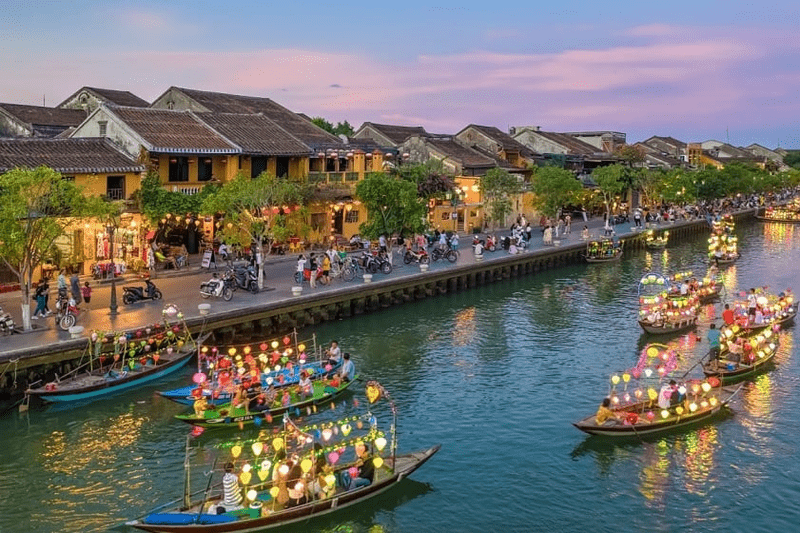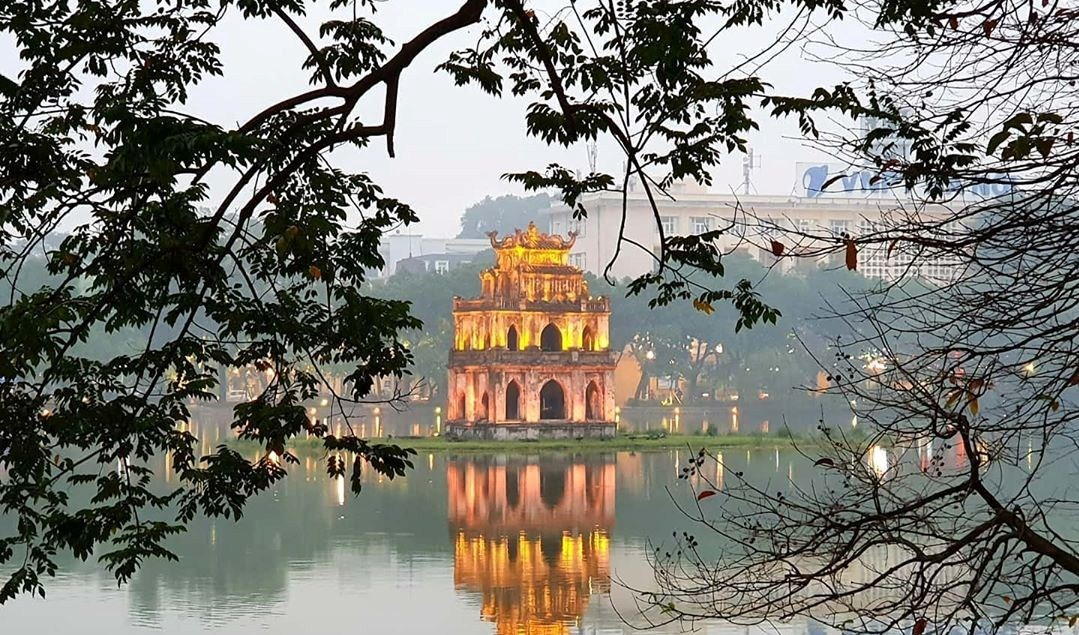Vietnam’s most popular tourist attraction is Halong Bay, which is also recognized as a UNESCO World Heritage Site. A remarkable array of countless limestone islets and islands, as well as magnificent caverns, add to this landscape’s astounding grandeur. Cave in Halong Bay Vietnam touring is one of the most popular activities included in the schedule of each Halong Bay cruise. The six most well-known caverns in Halong Bay that are worth seeing at least once in your lifetime are highlighted in this article.
Sung Sot Cave (Surprise Cave) – Halong Bay’s largest cave
- Location: Bo Hon Island, 14km South of Bai Chay Port
- Entrance fee: US$ 2/person
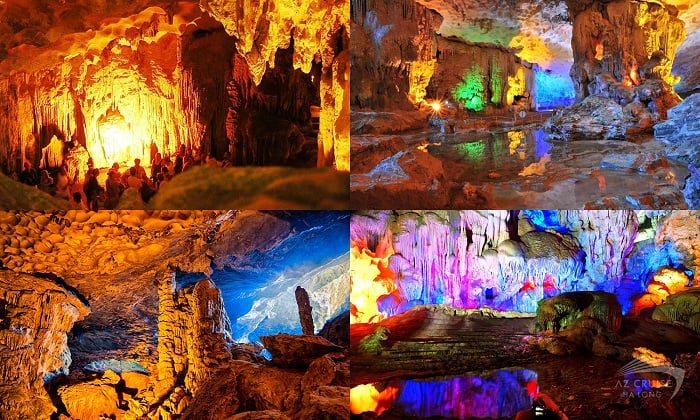
The origin of the cave name
Sung Sot Cave in Halong Bay Vietnam is the biggest, most well-known, and most frequented cave. First discovered in 1901 by French explorers, the cave was named Grotte Des Surprises (The Cave of Surprises) in a 1938 tourist guide. That certainly explains the term “Surprising,” since the cave’s enormous interior still surprises visitors despite a modest gate.
Highlights of the cave
The route to Sung Sot Cave is shaded by a profusion of trees. Travelers may have the thrill of traveling toward the sky while ascending steep granite stairs, giving them the impression that they are climbing a mountain. The cave is 10,000 square meters in size, with a passageway that is 500 meters long and 30 meters high.
There are two divisions in the cave: the inner and the outside. The first one has hundreds of stalactites hanging from the ceiling, giving it the appearance of a theater. The second chamber, where a stream of natural light glitters, is reached by a short tunnel. There is a big natural skylight that allows light to stream in from above. This opening serves as the cave’s exit. This chamber has a “royal garden” at its base with a pond, a magnificent panorama of tiny mountains, and real plants and birds.
Upon passing through a little tunnel into the second chamber, guests are treated to a whole new area that can hold thousands of people. A stone horse stands by the door, accompanied by a long sword. An invasion was vanquished by Thanh Giong, also known as Phu Dong Thien Vuong, a legendary folk hero in Vietnamese history, according to an old legend. Later on, after assisting the locals in driving out demons, he abandoned the horse and the sword to comfort the populace, drive out the demons, and return to the sky. There are rumored to be several ruins and scenes in the Cave in Halong Bay Vietnam that attest to the terrible combat between Thanh Giong and the invaders. In particular, the horse’s tracks turned into crumbling pebbles and little pools.
Dau Go Cave (Wooden Head Cave) – A Halong Bay cave with a diverse ecosystem
- Location: Dau Go Island, 4km from Bai Chay port
- Entrance fee: US$ 2/person
Dau Go Cave, regarded as the largest and most exquisite grotto in Halong Bay, was formed around two million years ago during the Pleistocene era. This about 5,000 m2 cave has an entrance that is 17 m wide, 12 m high, and 27 m above sea level. Tourists appear to enjoy such old, pure, and incredibly peaceful scenery when they explore Dau Go Cave.
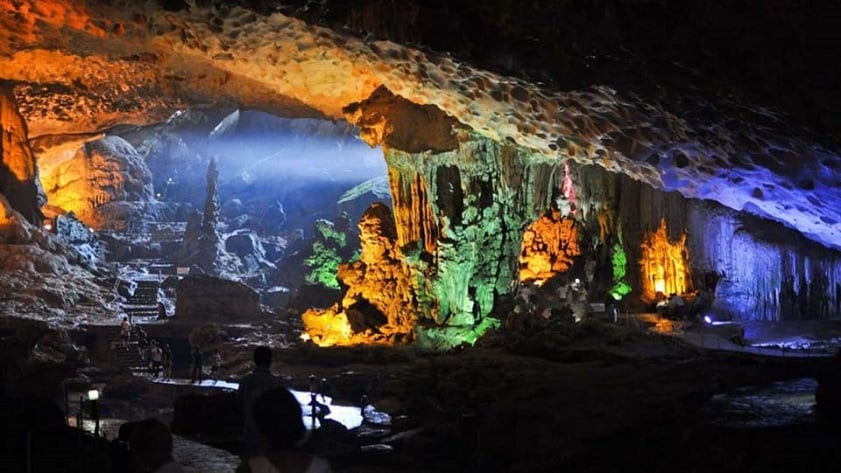
The origin of the cave name
Three reasons are linked to the naming of Dau Go Cave. The first idea states that Dau Go cave was originally known as Giau Go (Hidden Wood) because Tran troops used the cave to conceal wooden stakes during the 13th-century fight against the Nguyen Mong invaders before moving them to a spot beneath the Bach Dang River. According to the second explanation, fishermen would frequently congregate and repair their boats in the peaceful region in front of Dau Go Cave on the Dau Go islands. As a result, a large number of wood blocks remain, giving rise to the name Dau Go. The third explanation explains the name of the cave, Dau Go, by comparing Dau Go Island to a gigantic log from a distance.
Highlights of the cave
The gate of the cave has an emerald color from the outside and resembles a jellyfish. Dau Go Cave in Halong bay Vietnam, which has a dome height of 25 meters, resembles a mystery waterfall that is home to hundreds of stalactites. A stunning universe of stalactites and stalagmites in a variety of unusual sizes and forms will be revealed to your eyes. A massive image of several stalagmite animals awaits your wildest fantasy at the cave’s dome.
There are three main chambers in the cave. As you approach the first region, you could see a system of stalactites with a variety of images, including cocks, lions, and pythons. The second one features an amazing image of rocky islands surrounded by waves. The final section is distinguished by a vision of gentle, lovely, enormous stone columns. At the end of the cave lies a freshwater lake.
With a diverse range of plants and animals, Dau Go Cave is more exceptional than many other caves in Halong Bay. The cave’s large entrance, high humidity, and solar radiation have all contributed to the development of a complex ecology that includes woody plants, moss, and poplar trees.
Trong Cave (Male Cave)
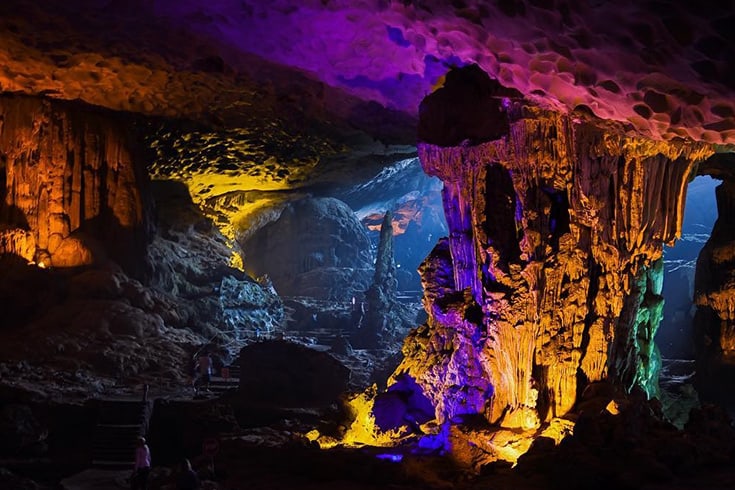
- Location: Bo Hon Island, 15km to the South of Halong Bay
- Entrance fee: US$ 2/person
Trong Cave is well-known for its distinct stalactite beauty as well as a love tale involving Trinh Nu Cave, the next cave (Virgin Cave).
The origin of the cave name
There is a story of a woman who fell in love with a fisherman but whose parents had her marry a richer guy. She fled to Trinh Nu Cave, a sea cave, to wait for the fisherman after refusing to comply with her parents’ request. The fisherman went to the sea to find her after learning of this news, but the storm knocked his boat into Trong Cave. They could hear each other’s voices and drums, but they were unable to communicate. Ultimately, the fisherman transformed into a tall stalactite column at Trong Cave (which translates to “male” in English) as they both passed away in sadness. Local fishermen now claim that on a particularly wet night, they heard the wind blowing down the rock and making a drum-like sound as they passed the Trong Cave (which is named after the Vietnamese word “Trong”).
Highlights of the cave
There is a striking large column of straight stalactites in front of Trong Cave’s entrance. It is said to be a representation of the legend’s fisherman. This cave’s most remarkable feature is its amazing assortment of stalactites and stalagmites in a variety of forms. Trong Cave in Halong Bay Vietnam is made up of two sizable gates that are divided by two cliffs and run east-west. Here, the glitzy scenery was formed by the silvery stalactites that hung down at the Eastern entrance. Visitors may feel the wind blowing into the rock and resonating back to the wall while they are standing in the cave; this sound is similar to that of a drum.
Me Cung Cave (Maze Cave) – One of Halong Bay’s most intricate caverns
- Location: Lom Bo Island, about 2km to the Southwest of Titov Island
- Entrance fee: US$ 3-4/person
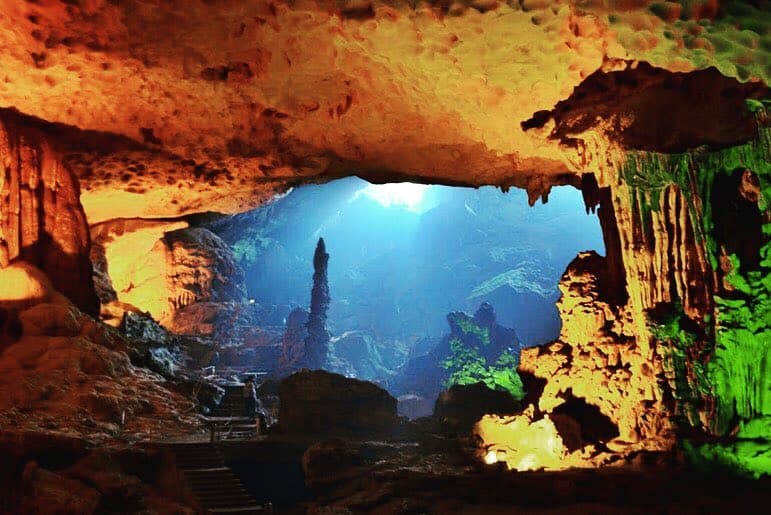
Archaeologists have determined that Me Cung Cave is one of the earliest Ha Long cultural sites, dating to between 7,000 and 10,000 years old. Me Cung Cave is situated around 25 meters above sea level, perched on a mountainside. Me Cung Cave’s entrance seems to be a home tucked away deep into the slope from a distance.
The origin of the cave name
The inside cave has an extremely intricate structure with several levels, chambers, and sections, including a passage spanning more than 100 meters. Me Cung Cave’s name could have come from its intricate interior layout, which features several partitions and a small volume. When visitors enter the cave, they may get a sense of being lost in an amazing maze.
Highlights of the cave
The entrance of Me Cung Cave is so small that it can fit only one person. However, the inside space of this cave is quite large and divided by limestone walls. Along the 100-meter path of Me Cung Cave, there are stalagmites and stalactites which are similar to the chandeliers and curtains of a marvelous palace. At the exit of Me Cung Cave lies Me Cung Lake, located on an airtight island surrounded by imposing mountains. This includes a world of creatures such as fish, shrimp, crabs, squid, etc. as well as algae, corals, and sea cucumbers, which develop the raising of many special animal and plant species in Ha Long Bay.
Me Cung Cave is well-known not just for its exceptional and singular beauty but also for the historical and geological treasures found therein. The remnants of several marine animals from millions of years ago may be seen on the cave’s limestone walls. Furthermore, investigations have shown that prehistoric humans lived in Halong throughout the Stone Age.
Luon Cave – Halong Bay’s unusual arch-shaped cave
- Location: Bo Hon Island, South of Halong Bay, 14km South of Bai Chay Port
- Entrance fee: US$ 1.3/person
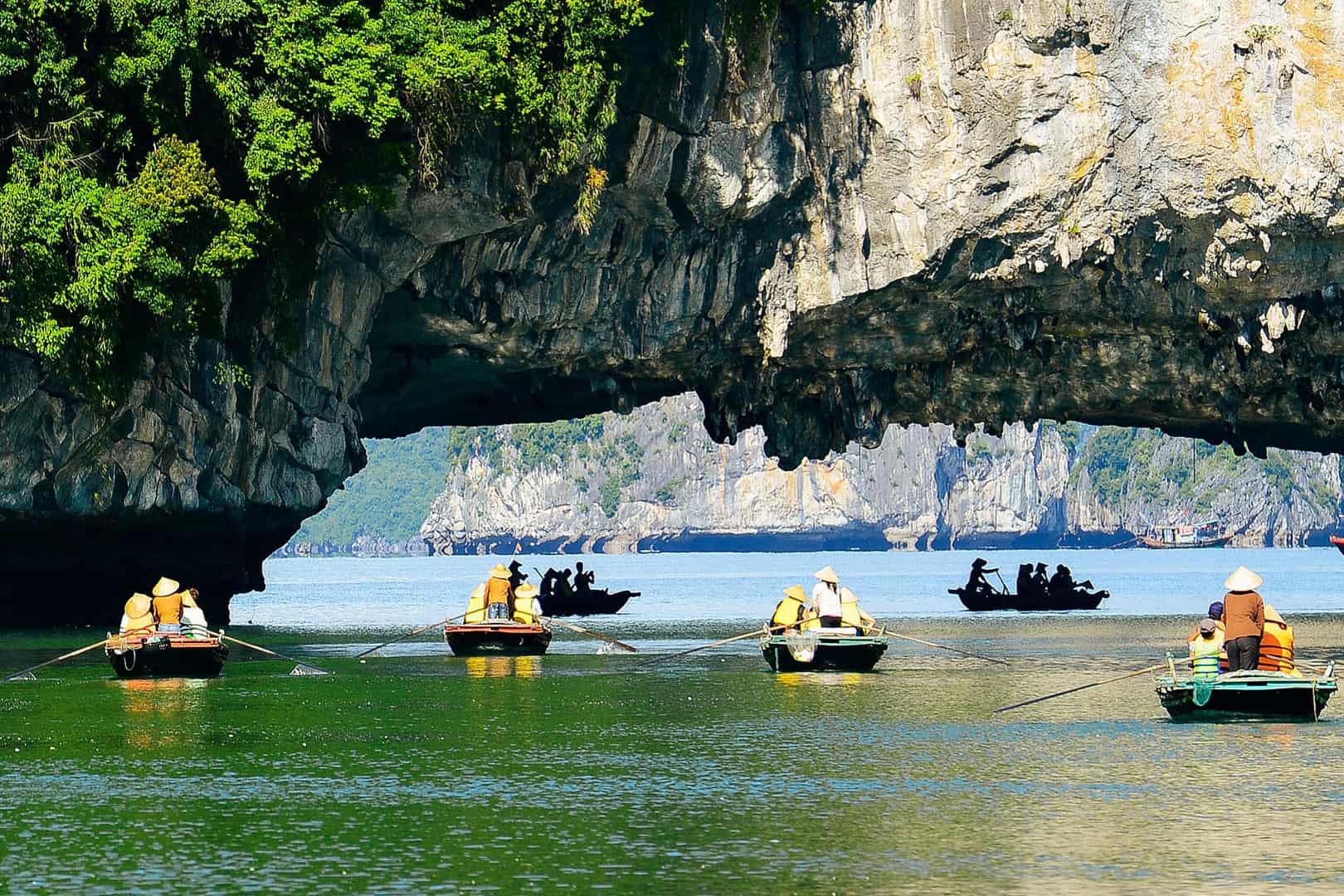
The origin of the cave name
One of the most unusual caverns in Halong Bay is Luon Cave, which has a closed arch-shaped mountain with a self-contained lake inside. This set of confined islands is barely 4 meters wide, 3 meters tall, and 100 meters long until it comes to the sea. Four mountains around the fresh lake in the cave, which is roughly one km2 in width. There is a “tunnel”-style water cave connecting the cave to the ocean. Travelers can either take a bamboo boat rowed by a native or row a kayak to enter. The cave’s unique structure may have given rise to the moniker “Luon.”
Highlights of the cave
Luon Cave in Halong Bay Vietnam is 60 meters long and 2.5 to 4 meters tall, depending on the height of the tidal surge. Due to its pure and scenic features, which include an amazing stalagmite structure, a serene green lake that serves as a year-round mirror, and a steep rock, the cave draws people from all over the world. The breathtaking natural setting consists of massive mountains, a clear blue sky, emerald water, lush vegetation, and clean air.
A diversified ecology with lush vegetation, enormous trees, aromatic orchids, monkeys, and abundant undersea marine life may be found inside the confined cave. Because fossilized freshwater shells were found on the grotto wall, it is thought that there was a hamlet here.
About 20 minutes are needed for a tour of the cave investigation. Nonetheless, if you want to really appreciate the peace and breathtaking beauty of the surroundings, you should spend some time kayaking.
Thien Cung Cave (Paradise Cave)
- Location: Dau Go Island, 4km from Bai Chay Port
- Entrance fee: US$ 2/person
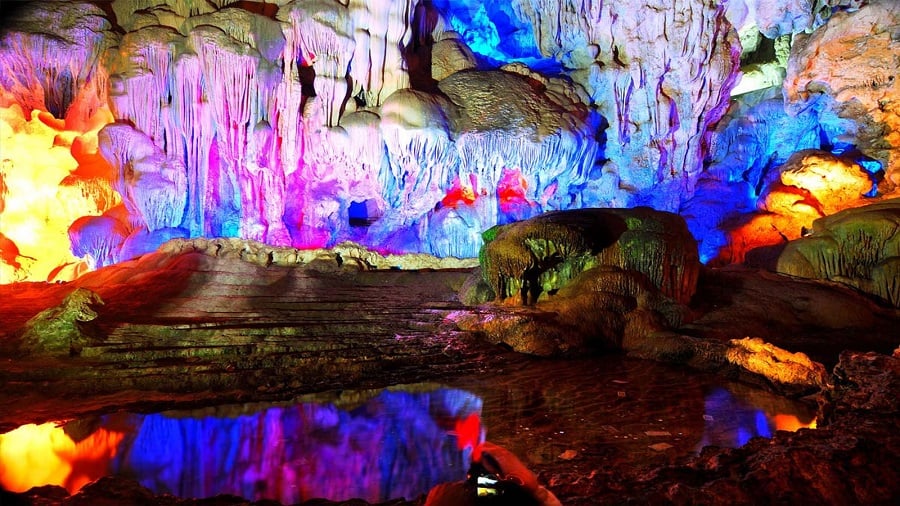
According to ratings, Thien Cung Cave is the longest dry cave in Asia and the most archaic cave in Ha Long Bay. It has an amazing system of uniquely shaped stalactites and stalagmites. The cavern’s breadth is around 10,000 m2, and its intricate construction consists of several floors and chambers with incredibly tall and expansive walls and ceilings.
The origin of the cave name
The cave is thought to be connected to a myth about an old Dragon King who drove away invaders and went back to his cave without accepting any tribute. Dragon Prince thereafter wed May, a female. Huge pythons, enormous eagles, and several dragons paid their visit to the wedding, which was held within the cave. You may view the sight etched into the walls and stones when strolling around the Northside. This explains why the cave is called Thien Cung Cave, which translates to “Heaven Palace.”
Highlights of the cave
A really large area lies behind a tiny entrance, which is sure to captivate first-time visitors. Characters from old fairy tales are naturally depicted in a massive painting found in the east of Thien Cung Cave in Halong Bay Vietnam. The sight of dancing and singing fairies will draw a lot of attention to the Northern cave.
Four enormous pillars that are carved in an odd assortment of shapes, from the bottom to the top of the pillar, including people going about their everyday lives, birds, flowers, and other objects, form the core of the cave. According to mythology, here is the location where Dragon Price and his spouse gave birth to a hundred offspring. Of these, half went on to protect the Bay while the other half explored other regions of Vietnam, creating new communities and paths with their mother. It is said that these youngsters are of ancient Vietnamese descent. After emerging from the cave, you will be greeted by a striking viewpoint that provides a comprehensive view of the whole Bay.
All things considered, every cave in Halong Bay has exceptional qualities that captivate tourists. You might locate a cruise that visits these caverns and pick your preferred location or destination. Vietnam Tour 247 provides amazing experiences if you enjoy visiting caves like Sung Sot Cave, Luon Cave, or Trong Cave. First-time visitors should find this information useful in better understanding the Halong Bay caves and in planning their next journey to this Natural Wonder Site.
Read more: Halong Bay Cruise – A Comprehensive Guide

